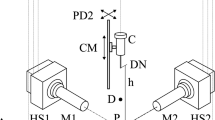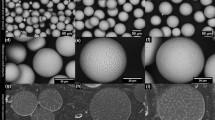Abstract
In this research study, the interaction of particles with substrates of different roughness magnitude was investigated. Particle surface treatment, relative humidity (RH), and surface roughness levels were controlled in order to achieve separation of different particles by applying removal forces. Three different approaches to reproducibly roughen surfaces were used. Initially, glass disks were laser engraved to create a reproducible, controlled roughness substrate. However, the laser engraving method produced surface features that were much greater in scale than the particles. These scale differences were such that the substrates produced were not of value to this research. The second option investigated to induce reproducible substrate roughness was to scratch the glass disk using sandpapers of known grain size. A third approach to establish reproducible roughness was to use fine stainless-steel wire mesh substrates. In tests with sanded glass disks, the interfacial energy of plasma-cleaned (hydrophilic) glass beads had a high variation at 40% RH, showing non-uniformity of area of contact between particles and substrates. As the RH increased, it was expected that the interfacial energy of hydrophilic particles would increase, but this behavior was not observed. In addition, comparing the interfacial energy results of hydrophilic particles with hydrophobic particles, a region with significant interfacial energy difference was not identified. In the case of the stainless-steel mesh substrate, the mesh asperities and particle dimensions were comparable. Thus, the smaller particles had more area of contact with the substrate than the larger particles. For the plasma-cleaned (hydrophilic) beads, the recovery values had an average of 92.5% recovery when the RH was between 46 and 85%. For the hydrophobic beads, the average recovery was 19.0% when the RH was between 46 and 75%. Thus, the hydrophobic characteristic of the particle influenced its lower interaction with the mesh substrate. The difference in recovery can be exploited to achieve separation of particles based upon adhesive forces.















Similar content being viewed by others
References
Moreno BaqueiroSansao B, Kellar JJ, Cross WM, Schottler K, Romkes A (2021) Comparison of surface energy and adhesion energy of surface-treated particles. Powder Technol 384:267–275
Moreno Baqueiro B, Kellar JJ, Cross WM, Romkes A (2021) Separation of particles of different surface energies through control of humidity. Miner Eng 160:106680
Johnson KL, Kendall K, Roberts AD (1971) Surface energy and the contact of elastic solids. Proc Royal Soc A 324:301–313
Packham DE (2005) Roughness and adhesion, Handbook of adhesion 2nd edition, 407-408
Packham DE (2003) Surface energy, surface topography & adhesion. International Journal of Adhesion Adhesives 23:437–448
Verrelli DI, Bruckard WJ, Koh PTL, Schwarz MP, Follink B (2012) Influence of particle shape and roughness on the induction peried for particle-bubble attachment,” in XXVI International Mineral Processing Engineering Congress - IMPC, New Delhi
Persson BNJ (2006) Contact mechanics for randomly rough surfaces. Surf Sci Rep 61(4):201–227
Pohrt LQR, Popov V (2019) Adhesive strength of contacts of rough surfaces. Front Mech Eng 5
Zimon AD (1982) “Chapter V”, in Adhesion of dust and powder. Consultants Bureau, New York
Fritzsche J, Urs AP (2016) Modeling adhesive force distributions on highly rough surfaces. Powder Technol 289:88–94
“Keyence,” [Online]. Available: https://www.keyence.com/ss/products/microscope/roughness/line/. [Accessed 11 05 2021].
B. M. Moudgil, S. C. Brown and I. U. Vakarelski, “Influence of nanoscale roughness on flotation,” in XXII International Mineral Processing Congress, Cape Town, 2003.
“The home of surface measurement,” Rubert, [Online]. Available: http://www.rubert.co.uk/faqs/roughness-parameters/. [Accessed 11 05 2021].
Zisman WA (1961) Relation of equilibrium contact angle to liquid and solid constitution. Adv Chem Ser 43:1–51
Owens DK, Wendt RC (1969) Estimation of the surface free energy of polymers. J Appl Polym Sci 13:1741
Good RJ, Girifalco LA (1960) A theory for estimation of surface and interfacial energies. III. Estimation of surface energies of solids from contact angle data. J Phys Chem 64:561
Fowkes FM (1964) Attractive forces at interfaces. Ind Eng Chem 56:40
van Oss CJ, Good RJ, Chaudhury MK (1986) The role of van der Waals forces and hydrogen bonds in “hydrophobic interactions” between biopolymers and low energy surfaces. J Colloid Interface Sci 111:378
Wenzel RN (1936) Resistance of solid surfaces to wetting by water. Ind Eng Chem 28:988–994
Zimon AD (1982) “Chapter IV”, in Adhesion of dust and powder. Consultants Bureau, New York
Kellar JJ, Cross WM, Romkes A (2018) Proposal to the National Science Foundation
Zafar U, Hare C, Hassanpour A, Ghadiri M (2014) Drop test: a new method to measure the particle adhesion force. Powder Technol 264:236–241
Funding
This work was supported by the National Science Foundation Grant #1805550 Sustainable System for Mineral Beneficiation.
The authors declare no competing interests. All authors certify that they have no affiliations with or involvement in any organization or entity with any financial interest or non-financial interest in the subject matter or materials discussed in this manuscript.
Author information
Authors and Affiliations
Corresponding author
Additional information
Publisher's note
Springer Nature remains neutral with regard to jurisdictional claims in published maps and institutional affiliations.
Rights and permissions
About this article
Cite this article
Sansao, B.M.B., Cross, W.M., Romkes, A. et al. Influence of substrate roughness on particle adhesion and concentration. Mining, Metallurgy & Exploration 39, 3–12 (2022). https://doi.org/10.1007/s42461-021-00521-9
Received:
Accepted:
Published:
Issue Date:
DOI: https://doi.org/10.1007/s42461-021-00521-9




